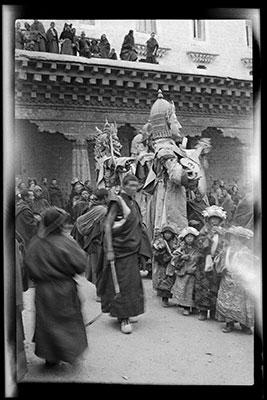
2001.59.9.40.1 (Film negative)


2001.59.9.40.1 (Film negative)

Hugh E. Richardson
Hugh Richardson
1949-50
Lhasa > Potala (foot of)
2001.59.9.40.1
55 x 85 mm
Ritual Activity
Negative film nitrate
Donated August 2001
The executors of the estate of Hugh E. Richardson
Hugh E. Richardson
Manual Catalogues - Notes on negative album - 'A'. CEREMONIES. SCAPEGOAT. SERPANG. ORACLE KARMASHAR. CHIPGYUR. LHA BSDUR NECHUNG. YASO. LUKHANG BOATS. GANGTOK WARRIORS.'
Manual Catalogues - Notes on negative index - Folio 40 [blank] [KC 20/9/2006]
M anual Catalogues - Richardson's Handlist - 'Vol. Album 'A' 21-48 'Tshog-mchod Gser-'phreng Other photographs in Album C nos 34-47. The Tshog mchod was instituted by Samgs-rgyas Rgya-mtsho in memory of the Vth Dalai Lama. The Gser-'phreng procession is said to represent a dream the Dalai Lama had. 26. Figures carried in procession, the Four Guardians of the Quarters and other deities'. [KC 17/09/2006]
Other Information - Background: Richardson describes the Sertreng ceremony in Ceremonies of the Lhasa Year, 1993, London, Serindia Publications, pp. 74-81. " ... a spectacular ceremony, the Sertreng, in which hundreds of participants marched round the Potala with banners, religious objects and music. ... the Koku - "The Silk Image" - a great appliqué banner which covers the lower face of he Potala for a space of some 75 by 40 feet. It consists of two panels, one rather larger than the other; in the centre of which is a huge figure of the Buddha surrounded by many deities and bodhisattvas. The privilege of hauling it up is enjoyed by the monks of the Pempora college of Drepung. ..." [KC 12/8/2006] "The rocky slopes of the Potala hill are already crowded with onlookers who also surround the open space at the west end of the Sho precinct under which lie the state graneries. ... Then at intervals throughout the morning different dancers in a great variety of dress come in succession. (pp.76-7) [KC 18/09/2006]
Other Information - Setting: The Potala Palace is the winter Palace of the Dalai Lamas and the seat of traditional Tibetan government. The palace is know as several names by the Tibetan, Tse Podrang, ( rtse pho brang ) or more formally, Potala Podrang ( pho brang po ta la ) The first structure was established by the legendary Tibetan Emperor Song Gampo on Mt Marpori in 637. The original structure is said to have been 11 stories high and was destroyed by lightening during the reign of Emperor Trisong Detsen. The present structure was built by the 5th Dalai Lama on the foundation of the earliest ruins. The Potala is divided into two parts, the central upper part is known as the Red Palace ( pho brang mar p o) and the surrounding structure is know as the White Palace ( pho brang dkar po ). The Red Palace contains the main temple inside the palace and housed the reliquaries of the successive Dalai Lamas. The Red Palace also represents the original structure build in the 7th Century. Between 1645-1653 the 5th Dalai Lama added the White Palace and made it the seat of his government. Since the 17th Century, the White Palace has formed the main administrative offices of the Tibetan government and it became the seat of Tibetan government only in the 18th Century when the 5th Dalai Lama shifted his base from Gaden Palace in Drepung monastery to the Potala. There are said to be over 1000 rooms and over 200,000 images inside. The grounds of the Potala also housed a school known as Tse Lobdra ( rtse slob grwa ) 'The Peak School'. The students were mostly boys from aristocratic families and trained to become government officials. The palace was also the site of two printing presses the older one known as Ganden Phuntsog Parkhang ( dpa’i ldan phun phyogs par khang ) founded in the 17th Century and in 1920s the 13th Dalai Lama established the Shol Printing House ( zhol par khang ). [TS 27/6/2005]
For Citation use:
The Tibet Album.
"Guardians of the Four Quarters at Sertreng festival "
05 Dec. 2006. The Pitt Rivers Museum.
<http://tibet.prm.ox.ac.uk/photo_2001.59.9.40.1.html>.
For more information about photographic usage or to order prints, please visit the The Pitt Rivers Museum.
© The Pitt Rivers Museum